Sound Diffusers 101: Free DIY Diffuser Designs
Sound diffuser scattering simulation. Diffusers reduce echoes and reflections by scattering sound waves in many directions.
Sound diffusers (or diffusors) are an acoustic treatment that many people overlook. Why? Diffusers are mysterious, misunderstood and not everyone can justify their cost.
Luckily, if you don’t wish to purchase diffusers there is an alternative: you can build them! Enter, the DIY sound diffuser. While there are many different DIY diffusers, I believe our optimized “stepped diffusers” are the easiest to build. If you can use a hammer, you can make them… and if you know a thing or two about woodworking, feel free to make the more sophisticated designs I’ve provided.
Click here to download the free blueprints, or read on to learn more. If you want to see how I designed these (using optimization), check out the free diffuser design thesis.
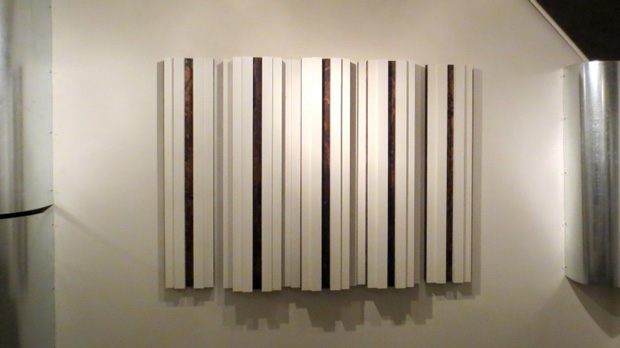
Sound diffusers arranged for peak performance (see the free DIY plans). Built by John White at WhiteConstructionDesign.com.
Download the DIY Diffuser Blueprints
↓
Stepped Diffuser Designs in Chapters 7.3 and 8 of “The Lean Optimization of Acoustic Diffusers” by Tim Perry are licensed under a Creative Commons Attribution-NonCommercial-ShareAlike 3.0 Unported License. Consult RPG Diffusor Systems Inc. for additional restrictions on fractal diffusers. Background research draws from the works of Trevor Cox, University of Salford; Peter D’Antonio, RPG Diffusor Systems Inc.
Acoustic Diffusers 101
Here’s everything you need to start building diffusers. I’ll be updating this page periodically, so check back often!
- What’s a Sound Diffuser?
- Free Blueprints for DIY Diffusers
- Acoustic Diffusion Simulation Videos
- Diffuser Performance: Sound Diffusion Coefficient Graphs
- Free Design Report: How Optimization is Used to Design Acoustic Diffusers
- Learn About the Various Types of Sound Diffusers (Chapter 2 of the Thesis)
- Free Report on Eco-Friendly Acoustic Materials
- Free Report on Recording Studio Acoustics (Including Diffuser Applications)
- Gallery: Photos of Sound Diffuser Builds
- FAQ: Frequently Asked Questions about these DIY Sound Diffusers
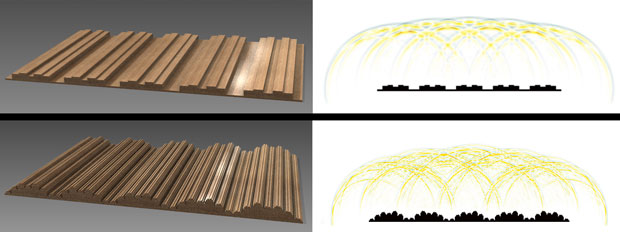
Acoustic diffuser designs. Modular, optimized stepped diffuser (top). Fractal diffuser (bottom). Scattering simulations (right).
What’s a Sound Diffuser?
A sound diffuser is an acoustic panel used to treat echoes and reflections. Unlike absorption, diffusers preserve the liveliness of your room because they don’t absorb much sound energy. Instead, they disperse it, spreading the energy around the room.
An ideal acoustic diffuser is a surface that causes an incident sound wave from any direction to be evenly scattered in all directions.
Optimized Stepped Diffusers and Fractal Diffusers
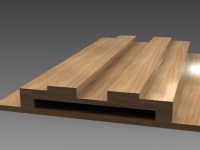


To design these diffusers, I used a system that combines evolutionary optimization (simulated natural selection) with physical modeling. If you’re interested in the nerdy details, check out Chapters 6-7 of the diffuser design thesis.
The thesis gave birth to many possibilities for modular sound diffusers (large diffusers, assembled using small diffuser panels called modules). Here are the most promising designs:
- The Leanfuser™ (called A1-LF in the thesis) — a ridiculously simple, low profile, modular stepped diffuser. This is the easiest sound diffuser panel to make (way easier than building a DIY QRD diffuser or DIY Skyline® diffuser). Many people have been surprised at how quick these are to build, and how well they perform! (See the thesis for an extended design called A1-Frac, or the Leanfractal™)
- The Stepfractal™ (called B2-Frac in the thesis), which offers better high frequency diffusion but is less DIY friendly. This was designed by optimizing diffuser modules in an aperiodic array (explained in Chapter 7 of the thesis). Next, the optimized module’s shape was used to generate fractal geometries. Fractals are an elegant way to extend the bandwidth of the diffuser, improving its ability to scatter sound at higher frequencies.
- The Leanfractal™ (called A1-Frac in the thesis), a fractal version of the Leanfuser™. This diffuser offers the low profile, modular benefits of its little brother, with an extended diffusion bandwidth for better high frequency performance. This is my best diffuser design.
The RPG Diffractal® (a nested broadband QRD diffuser) inspired me to optimize simple diffuser panels that can be easily fractalized. To protect the open source status of these acoustic diffuser designs, I’ve licensed them under Creative Commons. The diffusers are free for you to build and use, but please don’t manufacture them with the intent of selling them.

DIY sound diffusers. Modular, optimized stepped diffuser (left). Modular fractal diffuser (right).
DIY Sound Diffusers: Free Blueprints
These sound diffusers have been optimized to balance performance with simplicity, so you can easily build them using basic tools.

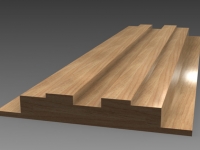
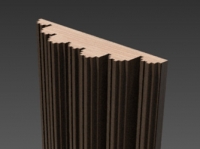
Here are the free blueprints:
↓

Diffuser panel fabrication drawing (5 modules side-by-side make a full diffuser).

DIY sound diffuser panel assembly (showing fabrication cuts for a full height module).
Coming Soon: More Videos of Sound Diffusion in Action!
The Acoustic Diffuser Build Gallery (Click Here to Visit)
Studio and venue owners, home recording hobbyists, hi-fi enthusiasts, audiophiles and many others all over the world have built these diffusers. Here are photos of some example builds.
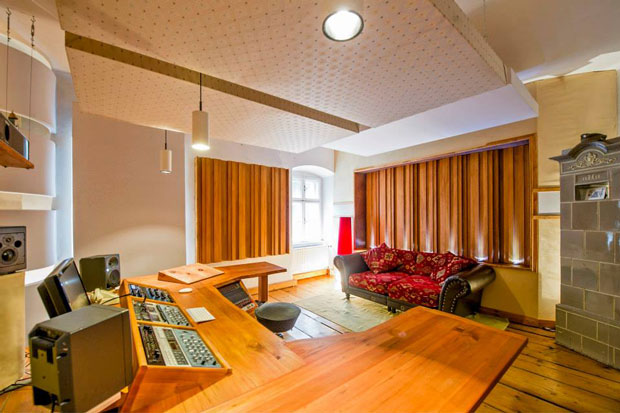
Leanfuser panels on the walls of Audiobomber’s Castle Mastering (Alexander Jöchtl’s mastering studio at Castle Wildberg in Upper Austria). Photos by Karin Lohberger Photography.

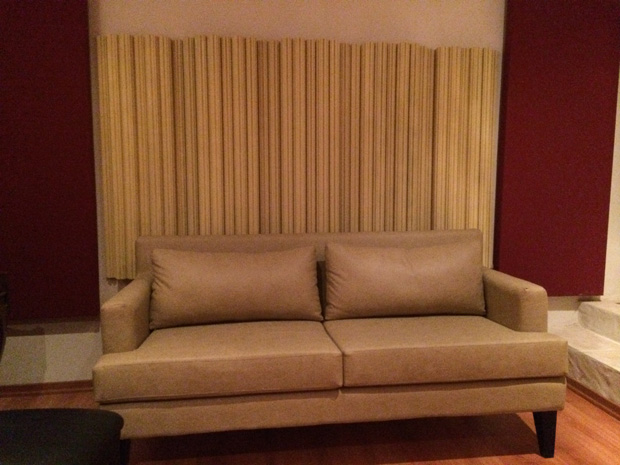
Fractal sound diffusers DIY build: 5 Leanfractal (A1-Frac) sound diffuser panels assembled using Profiled Modulation 1. Note that couch is not used for critical listening (the diffusers are not designed for such close proximity). Built by Pablo Crespo.
Diffusion Coefficients: How Well do the Diffusers Perform?
The autocorrelation diffusion coefficient is used to measure diffuser performance. In the images below (produced using AFMG Reflex Software), the diffusion coefficient has been averaged in one-third octave bands and plotted as a function of frequency.
High values of the diffusion coefficient indicate that a surface scatters sound uniformly to all receivers. Low values tell us that a surface is concentrating reflected energy in one direction. The higher the coefficient at a particular frequency, the more effectively sound is diffused at that frequency.
RPG Diffusor Systems® is currently developing more advanced acoustical coefficient standards.
Detailed reports showing plots of the sound diffusion coefficient spectra for these diffusers — and other optimized diffusers — are available here.
Get the Detailed Performance Reports
(Free Instant Download)
Stepped Diffuser A1-LF (The Leanfuser™) Performance Coefficients
If you plan to use an array of diffuser panels, the diffusion coefficient graphs for a single panel don’t mean much. But for curiously, lets start by looking at a single panel.
The measurements below assume the diffuser is flanked by broadband absorption on either side. The diffusion coefficients would be reduced if we placed a hard wall on either side of the diffuser.

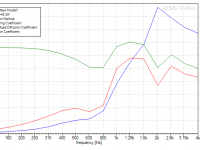

Now, let’s put 5 diffuser panels in a periodic array. As you can see below, the diffusion coefficients are reduced. This is expected because periodicity causes acoustical lobing, which results in uneven scattering (explained in the diffuser design paper).
Luckily, there is a much better way to arrange Leanfuser™ panels, which I’ll show you next. You’ll see how to use modulations to get rid of the periodicity and dramatically improve the diffusion performance.
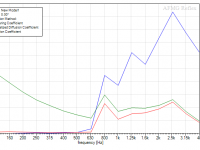

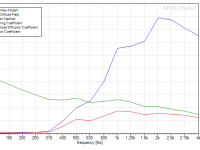
Applying Profiled Modulations to The Leanfuser™
Because the Leanfuser™ panel is symmetrical, 5 panels placed side-by-side form a periodic array. A great way to improve the diffusion performance is to reduce this periodicity by mounting the panels at different depths. I call this a profiled modulation.
The image below shows an example, where 5 Leanfuser™ panels have been mounted at specific depths (see the blueprints to learn how to apply this modulation).

Sound diffusion coefficient plots for stepped diffuser A1-LF with a profiled modulation (5 panels mounted at specific depths).
This gives a big performance boost, as you can see from the diffusion coefficient plots.
You can also mount 7 panels using a profiled modulation based on fractal self-symmetry. The image below shows an example of this, where 7 panels of the Leanfuser™ are mounted at different depths to create a shallow profiled modulation.
You can call this a fractal modulation, because the profiled modulation is derived from the depth sequence of the Leanfuser™. And, if you applied this modulation to the fractal diffuser A1-frac (the Leanfractal™), you’d have a 3rd order nested fractal!
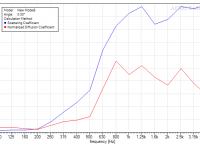
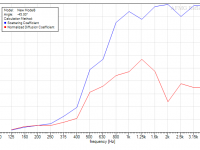

If you wanted to build a deeper diffuser, you could take the fractal self-symmetry concept even further. For example, you could create a low frequency fractal stage with the proportions equal to the stepped diffuser proportions (I.e., keeping the width:depth ratio consistent).
For the Leanfuser™, the width:depth ratio = 42 cm / 5 cm = 8.4. Considering an array of 7 acoustic diffuser panels (294 cm wide), the deepest step of the profiled modulation would be 294 cm / 8.4 = 35 cm. Since the deepest step of this stepped diffuser is 5 cm, you would scale all the depths by 35 cm / 5 cm = 7.
This would give you a profiled modulation of 7x[stepped diffuser depths]. The resulting diffuser would have an operational depth of 40 cm, which is a much deeper design than the one we started with!
Fractal Diffuser B2-Frac (The Stepfractal™) Performance Coefficients

Simulation of fractal diffuser B2-Frac (single module). Assumes the diffuser is flanked by absorption (not reflective walls).
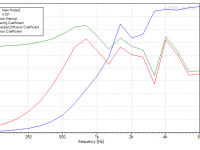
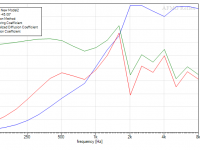
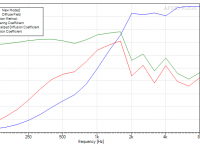
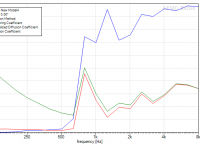
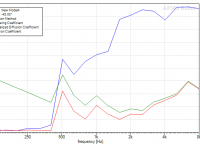
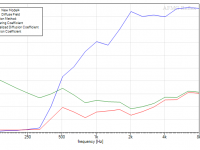
Diffusers with High Sound Absorption Coefficients (Diffsorbers)
In addition to diffusion, all diffusers will exhibit a small amount of absorption (measured using the sound absorption coefficient). In general, the rougher the surface, the more absorptive, so fractal diffusers tend to be more absorptive than their non-fractal siblings.
Some absorption is inevitable, but to minimize it, varnish the surface of your acoustic diffuser panels to make the material as reflective as possible. This applies to stepped diffusers, QRD diffusers, primitive root diffusers (PRD) like the RPG Skyline®, and all diffusers that consist of a hard, uneven shaped surface. Most of these fall into the category of reflection phase grating diffusers, or Shroeder diffusers.
But absorption is not always a bad thing. Some acoustic surfaces, like MLS diffusers, incorporate absorption by design. Without it, they won’t function!
These hybrid diffuser / absorber surfaces are sometimes called diffsorbers. An example is the Wavewood panel by Vicoustic, which is a modified MLS diffuser.
Some diffsorbers look like regular sound absorbing panels, covered with acoustically transparent fabric. But, if you were to remove the acoustic fabric finish from one, you would see it’s designed to function as a combination absorber / diffuser (absorptive at lower frequencies, diffusive at higher frequencies).
An example is the thin, flat, BAD Panel by RPG (a 2D binary amplitude diffuser, or binary amplitude diffsorber). If you overlay the diffusion and absorption coefficient charts for the BAD Panel you will see a combination of diffusion and absorption between 1-2 kHz, and pure absorption below 1 kHz.
You can learn more about hybrid surfaces and other types of acoustic diffusers in this free report.
More Diffusion and Acoustic Treatment Resources
Check out the thesis to learn more about these diffusers and see how they were designed. Or, learn more about the practical applications of acoustic diffusers in the recording studio design papers.
↓
(Free Instant Download)
Many of you have told me you’d rather not build diffusers yourself and you simply want to buy them. Thanks for the interest, but right you can’t buy any diffusers I’ve designed! If you want them, you have to build them (or hire a carpenter to build them for you).
But if you really don’t want to build sound diffusers, and instead you want to buy them through me, check out the diffusers section of our acoustic treatment store. There you can learn about some of the acoustic treatments on the market by RPG Diffusor Systems and Vicoustic. For example, if you love the look of the RPG Skyline diffuser and you want a nice wood alternative, check out the Vicoustic Multifuser. You won’t find any cheap, ugly plastic diffusers on this site, but you will find some slick acoustic diffusers made from wood and bamboo.
Still looking to do your own build? Great! Download the free blueprints and I’ll send you all the information you need to get started. For answers to the most common DIY diffuser build questions, check out the FAQ and take a look at the build gallery.
Over to You — Build Your Own Acoustic Diffuser Panels
Now go ahead and build them, and please leave a comment below if you have any questions or insights! Also, I’m wondering
- What’s the most likely material you’d use for building them?
- What tools are available to you? Do you have access to woodworking equipment? CNC?
Depending where you live, I think bamboo lumber would be great construction material for DIY diffusers (and other acoustic panels). It’s a greener and cheaper alternative to hardwood, with a unique, exotic look. If bamboo does not grow near you, why not build these out of reclaimed lumber?
Perk: If you build any of my DIY diffuser designs with reclaimed wood, bamboo lumber or another eco-friendly material, please let me know! If they look good I’ll post photos of your diffusers, and (with your permission) I’ll link to your website.
by Tim Perry




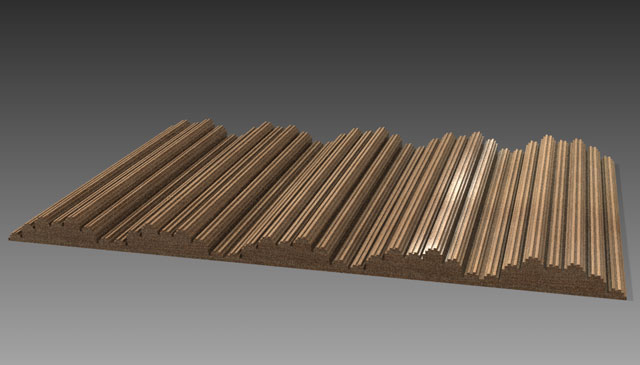
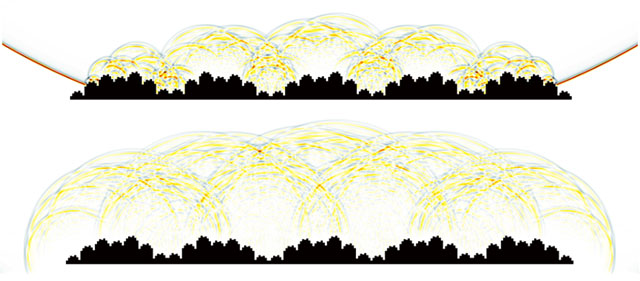
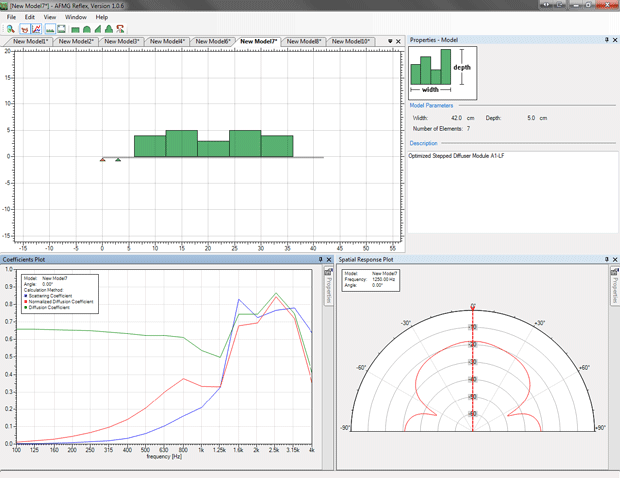
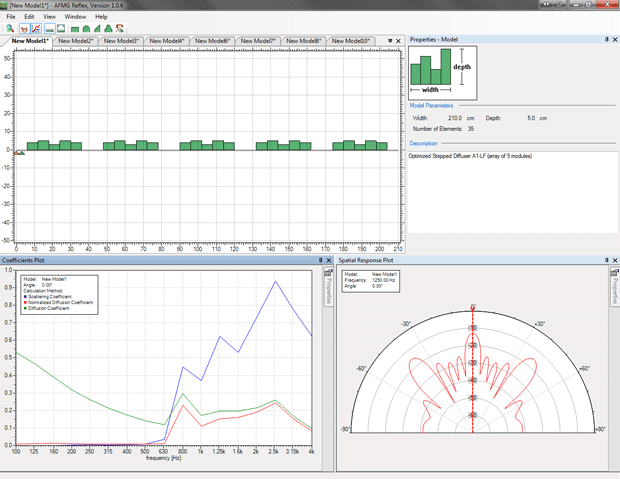
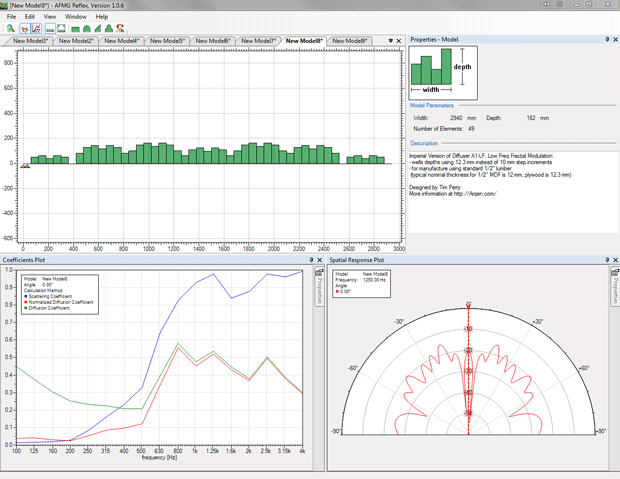

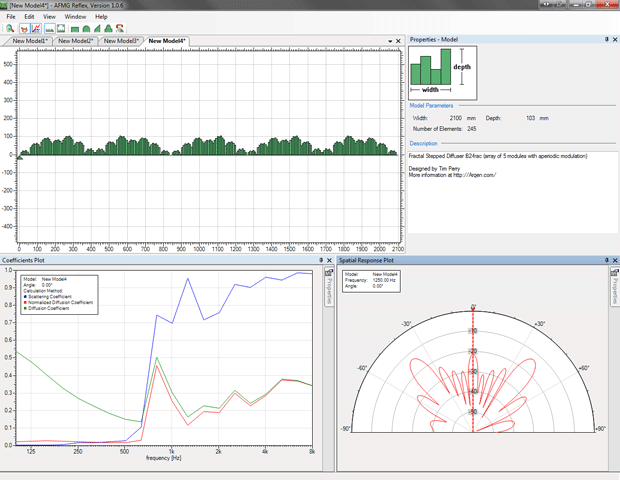
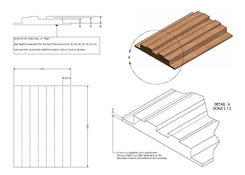
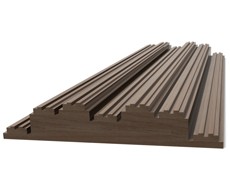
Pingback: Room Acoustics and Materials | de notre son()